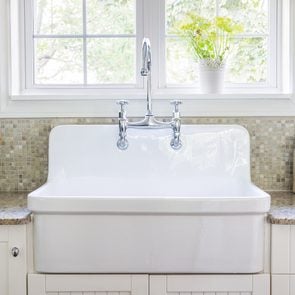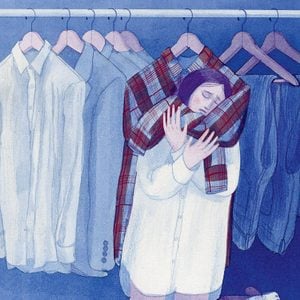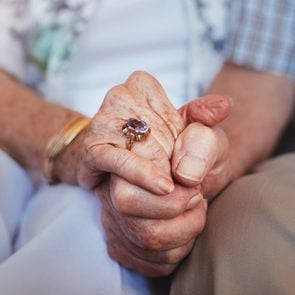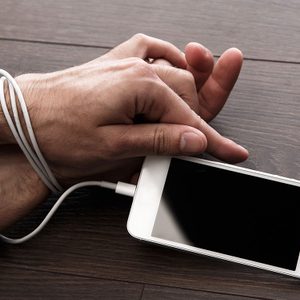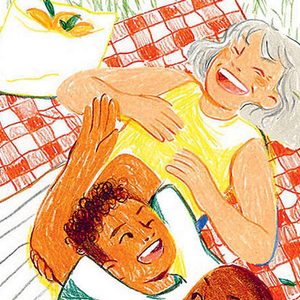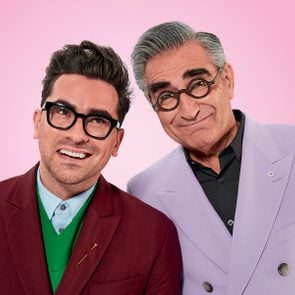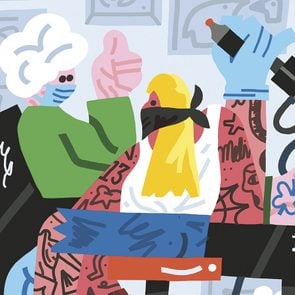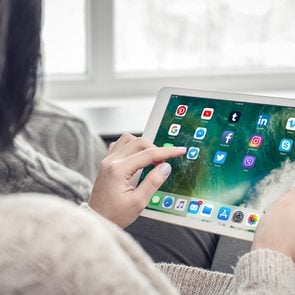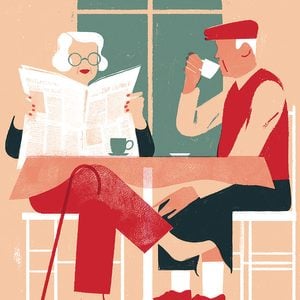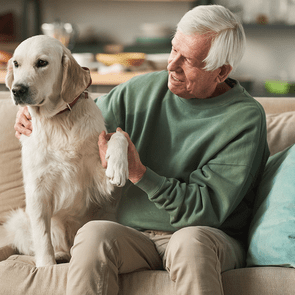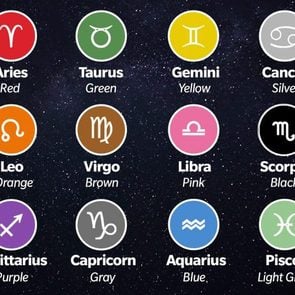When you think about it, your coffee maker is one of the hardest working appliances in your home. Day after day, and week after week, calcium and lime scale from your tap water can begin to clog up the works and make your coffee taste stale or slightly metallic. (Find out more mistakes everyone makes when brewing coffee.) The good news? When we asked cleaning experts how to clean a coffee maker, they said the answer was as simple as good, old-fashioned white vinegar.
How to Clean a Coffee Maker With White Vinegar
Pour in enough full-strength white vinegar to complete a typical brew cycle and then run the cycle as usual. Let the vinegar sit in the pot for 30 minutes before pouring it out. Follow with a couple of plain-water brew cycles to rid your coffee maker of the vinegar-y smell and taste.
Coffee tasting weak? You probably need to unclog the plastic plate that sits above the basket. A toothpick should do the trick! (Here are more clever cleaning hacks that take the hassle out of housekeeping.)
Deep-Clean Your Coffee Maker Carafe
To clean built-up stains inside the carafe, sprinkle the interior with baking soda and warm water. Allow it to soak for 10 to 15 minutes. Then, scrub well and wash thoroughly. (Don’t miss these other brilliant uses for baking soda.) Some coffee drinkers have reported great success with detergent dishwasher pods. They recommend putting one pod in your tannin-stained carafe, filling it with hot water and allowing it to soak. Follow with a thorough wash.
Stain still there? Try a Magic Eraser or a commercial product such as Whink Coffee Maker Cleaner, which is made with sulfamic acid and hydroxyacetic acids (much stronger than vinegar’s acetic acid). Fill the carafe with hot water and Whink, soak for a few hours and then wash with dish soap and hot water.
Surprise—here are seven ways you’re shortening the life of your coffee maker without even realizing it.
Reader’s Digest Canada: After more than 20 years delivering babies, you switched to performing assisted deaths. How come?
Stefanie Green: I’ve always been interested in the intersection of medicine, ethics and law. Working in maternity care, I was able to engage with those topics in terms of women’s health and reproductive rights. Meanwhile, I was watching the evolution of assisted dying legislation in Canada. I started thinking, well, yes, the law might change, but who is going to do this very important work when it does?
You mention Canada’s decriminalization legislation. When and why did that happen?
In Canada we had some landmark cases that challenged the blanket prohibition of assisted dying as a violation of charter rights, and the Supreme Court agreed in a unanimous ruling. Bill C-14 was then introduced in 2016, creating a number of parameters regarding consent, capacity and the stipulation that to qualify for assisted dying, your natural death had to be “reasonably foreseeable.”
Which means what exactly?
Well, that was the issue. Does reasonably foreseeable mean weeks? Months? Years? What about people with conditions like ALS or Parkinson’s? I think the intention with that language was to give some leeway to clinicians, but it ended up being limiting because there was fear of the consequences—ethical and legal—over making the wrong call.
In March 2021, the government amended the assisted dying law, Bill C-7. What’s new?
Death no longer has to be “reasonably foreseeable,” which opens up assisted dying to a far larger group, including people with non-fatal, long-term chronic pain conditions. And C-7 introduced a waiver of consent, which means certain patients can enter into a written agreement that will remain valid even if the patient loses mental capacity before their scheduled death. This is a huge win. Probably the hardest moments of my career have been showing up to perform an assisted death and the patient has unexpectedly lost capacity because of pain medication or an advance in their condition. Saying no to their loved ones even though we know this was the patient’s wish has been heartbreaking.
How do the current laws on euthanasia in Canada address people with mental health issues?
For now, patients with an underlying mental health disorder cannot apply for assisted death if that disorder is their only underlying condition, but that restriction has an expiration date—which is a way of giving the government time to consider options. Most mental health issues by definition interfere with our mental state, so there is a significant concern about whether those patients will have the capacity to make this particular decision. That said, there is a difference between an irrational suicidal thought and a rational wish to end your life due to suffering, so the question is: how do you tease these two things apart? The government has assigned a task force of medical and legal professionals to make recommendations.
In your book you talk about the relief that people feel during their first appointment. Can you explain?
Most people shy away from talking about death, but in my work I use a script that is very frank. I say, okay, we’re going to talk about death. We’re going to talk about your death and assisted dying. Whether I end up helping them or not, there is so much gratitude just to be able to have these conversations. Not because they want to die, but because they want to have control and autonomy, which is so essential to a dignified death.
Check out Stefanie Green’s new book, This Is Assisted Dying.
For practical advice on getting your own affairs in order, consult our end of life planning guide.
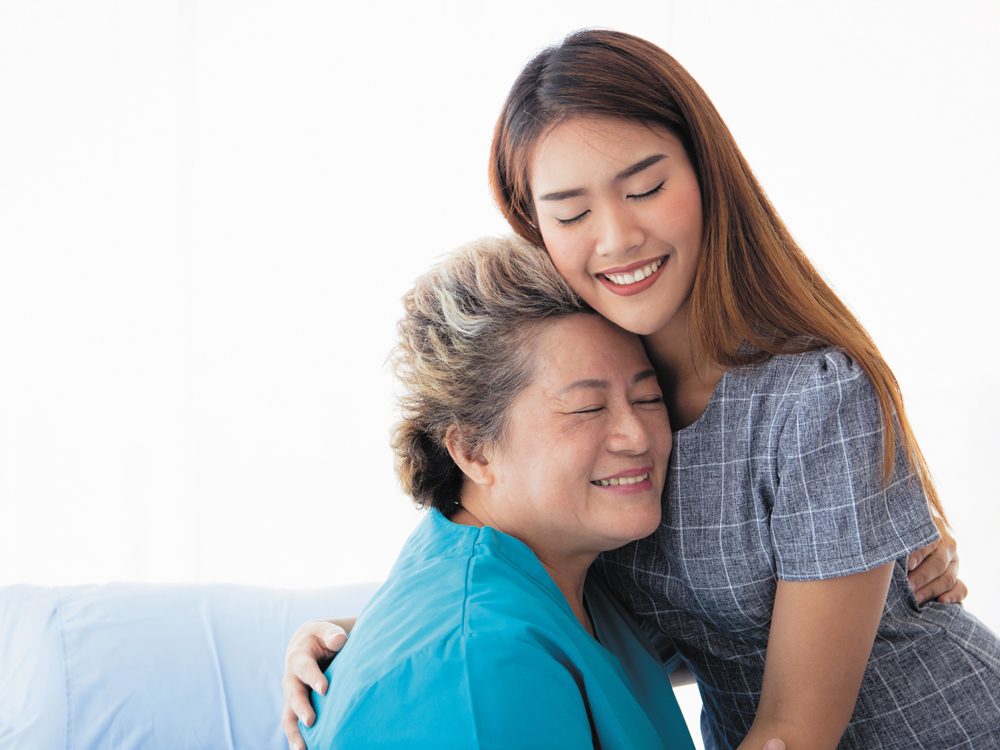
If you’ve found yourself in the role of caregiver, it’s totally normal to feel a bit overwhelmed. You want to make sure you’re doing the best you can for your loved one, while also juggling your own needs. But you know what doesn’t have to be a struggle? Incontinence. Follow these steps and make handling incontinence just another part of life.
Step 1: Choose easy-to-change absorbent products.
No one wants to sit in wet underthings, which makes stretchy, breathable briefs with leak protection an absolute must-have. It’s also key to choose a style that’s easy to remove, whether that means comfy pull-up underwear or a stay-in-place fit with tabs. For nighttime, look for products with extra protection to keep your loved one dry and odour-free all night long. There are disposable products specifically design for nighttime use which offer a higher level of absorption and a fit that help ensure your loved one won’t have leaks during sleep.
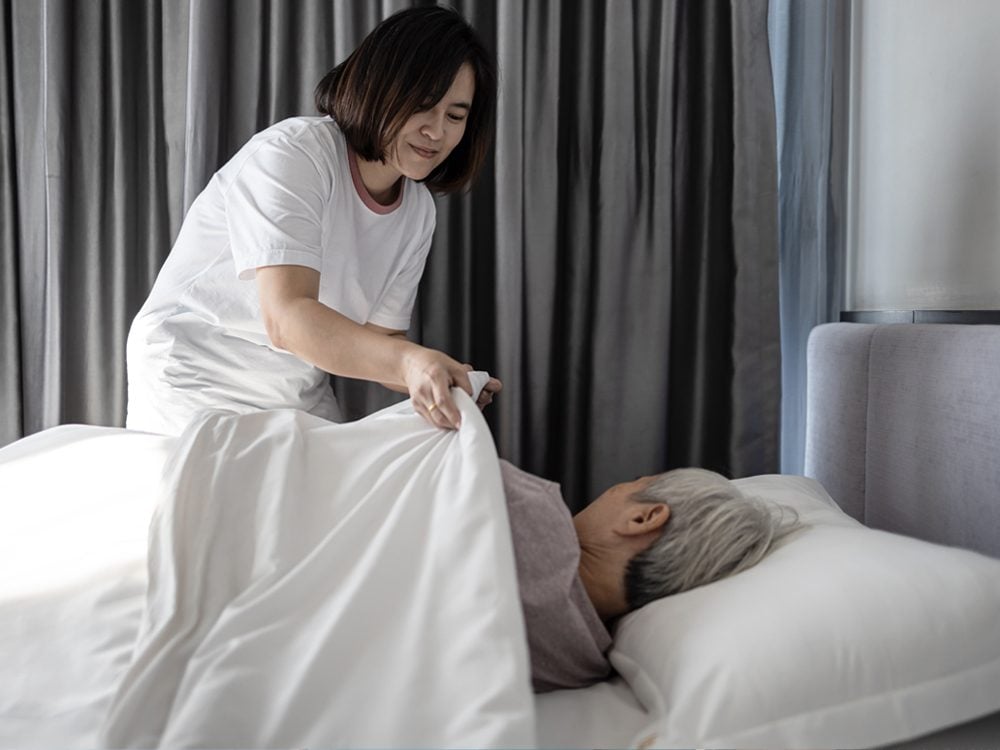
Step 2: Make clean-up quick and simple.
Incontinence may cause skin irritation and chafing, but having a good care routine will help. That said, cleansers that contain alcohol or harsh disinfectants can lead to soreness and even rashes, while washing with water multiple times a day can cause the skin to dry out. A gentle cleansing cream is a great solution for daily cleaning because there’s no rinsing necessary. Pre-moistened cleansing wipes with soothing ingredients like aloe and chamomile are also great on the go. The result? A fresh feeling whether your loved one is out for a stroll, playing with their grandkids or reading a book in their favourite armchair.
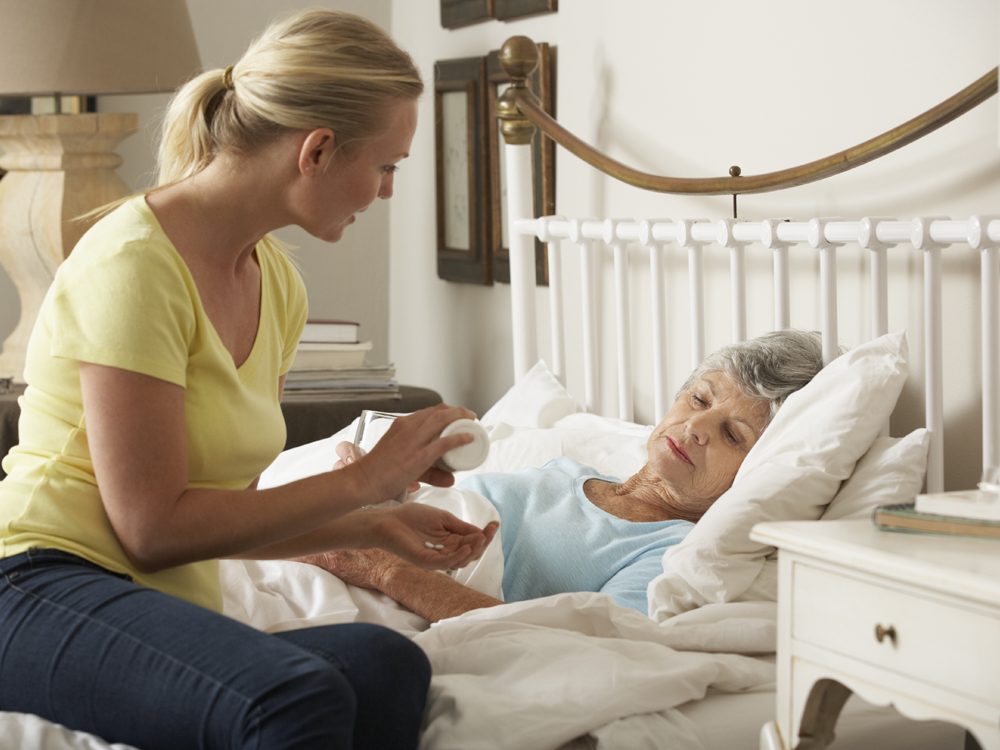
Step 3: Protect delicate skin for comfort all day and night.
There’s another comfort component for delicate skin: barrier cream. Applying a protective, fragrance-free cream that absorbs easily can add a layer to skin that safeguards it against moisture, especially if garments can’t be changed immediately every time.
Being a caregiver isn’t easy, but the right tools used at the right time can make everything a little less complicated. For more information about TENA’s range of intimate products including absorbent briefs, cleansing cream, wipes and barrier cream (plus plenty of tips for caregivers!), visit tenacaregiver.ca.

The scientific reason boredom is good for you
Reader’s Digest Canada: Boredom gets a bad rap. But is there an upside?
John Eastwood: Absolutely. Its function can be compared to that of pain, which provides feedback to prevent us from damaging our body. Boredom does the same work to protect us from stagnation. If we were content to be mentally unoccupied, we might never learn, explore, grow, discover.
These days, we’re constantly stimulated, arguably over-stimulated, by technology. Has it led to a decrease in boredom?
It may actually be making us more prone to boredom. Technology grabs our attention, but it does that by turning us into objects rather than agents. Instead of sitting down with our thoughts or complex ideas, we’re giving our minds over to a screen—and our capacity for willful focus and attention may atrophy through disuse. There’s also an addiction metaphor that’s used: technology messes with our brain, giving us a constant high, and then we need even more stimulation to feel satisfied, to get that fix.
Sounds like we need to get better at being bored.
It’s more that we need to engage in activities that might make us feel bored without succumbing to it—like going for a long walk by yourself without your phone.
Easier said than done. Most people take their phone to the bathroom!
Absolutely. To move away from that you can practise basic exposure therapy: head out on an errand without your phone or read something that is longer than a sound bite. Initially you will feel the discomfort of boredom—that urge to reach for your screen. But after a while you won’t miss it as much. You may even find you enjoy letting your mind wander.
Which is different from boredom?
Getting lost in one’s own thoughts is probably the exact opposite of boredom.
I read about a study where people were left alone in a room to either sit with their own thoughts or electrocute themselves. And a lot of them opted for the latter.
I know of that experiment. I think it’s important to note that for a lot of people the choice to shock themselves may have been based on curiosity, and that no other activity was on offer. That said, there is evidence that non-suicidal self-injurious behaviour is correlated with boredom. For instance, animals in captivity pull their feathers out when they’re under-stimulated.
It seems like a lot of kids today will say they’re bored pretty much any time they’re not being entertained.
There’s a lot of pressure on parents these days to treat our kids like buckets that need to be filled with compelling experiences, structuring all their time and never giving them the opportunity to make a choice. The problem with this approach is that kids aren’t learning to be agents creating their own meaning in the world.
You’ve also said before that bored kids can play an important role in social progress.
Right. Young people being “bored” of their parents’ culture is a way they reject the status quo, which is how individuals and society move forward from one generation to the next. If kids didn’t get bored of their parents’ taste, we would all still be listening to Beethoven.
John Eastwood is the co-author of Out of My Skull: The Psychology of Boredom.
Now that you know why boredom is good for you, find out how little acts of spontaneity can help make your day.
I wish I could say her reaction that evening was an isolated incident, but it was one of many I remember when I was first starting out as a playwright.
Despite the fact I’d established myself as a humorist, my mother never found me or my work particularly funny. We loved each other deeply, of course, but she was my hardest critic. “Is Drew really that funny?” she’d ask family members.
To make matters worse, the feeling was mutual: though our social circle swore that she was hilarious, I never saw it. For starters, unlike me, she never had a clever spin on world events or the state of affairs in her community. How could she be funny?
My mother was supposedly very funny in her first language, Anishinaabemowin, but alas, I didn’t speak it. One of the most intriguing characteristics of a good deal of Indigenous languages, I’ve been told, is that they’re structured for maximum hilarity. At family gatherings, when somebody would say something “funny” in Anishinaabemowin, she’d lean over and explain it to me. Sometimes the humour translated. Sometimes it didn’t.
For a while I was convinced I would never make her laugh. Then, in 2005, I succeeded. I had published a book called, of all things, Me Funny. In it were dozens of essays deconstructing Indigenous humour, along with 50 so-called “Indian jokes” to break up the various chapters. (For instance, “Why do Native people hate snow? Because it’s white and all over our land.”) They cracked her up so much she looked at me and declared, “Wow, that was funny!”
I remember being relieved—and very pleased.
In 2009, my mother passed away of a stroke at the age of 77. I was in charge of planning the funeral along with two cousins, two aunts and my girlfriend. Because my mother was a shy woman, I can guarantee she would have found our group effort quite embarrassing.
Sunflowers were her favourite, but she had had the nerve to pass away just before the Chinese New Year. Since sunflowers are seen as a symbol of good luck and prosperity, the holiday had hoovered up all the bouquets in Ontario. We opted for her second favourite: asters. She would not have been impressed.
During the funeral, amidst the tears, family member after family member got up and recounted things she had done and said over the years. To my surprise, I found myself laughing. Suddenly I remembered a moment from the early ’90s, when my mother asked me, utterly serious, what “owie” meant in French. I struggled to come up with an answer until I spelled it out in my mind: oui.
More and more stories about her surfaced. We laughed as we remembered her.
I couldn’t see my mother’s forest for my own trees. I wish I could have shared those laughs with her while she was alive, but I’m glad I finally made the connection.
Next, check out a story that perfectly captures what it’s like providing tech support for your folks.

The world always seems a little brighter after a good sleep. And as any caregiver knows, you’re no good to anyone if you’re exhausted. Luckily, there are steps you can take so that you sleep longer and more deeply. They may even work to reduce middle-of-the-night wakeups for your loved one. Find one (or many!) that will work for you.
1. Skip food and drinks that make it hard to sleep.
Everyone’s different! Some people like to abstain from drinks in the few hours before bed. Others know they absolutely need a cup of tea and slice of toast to sleep well. But generally, it’s a good idea for caregivers and their loved ones to follow these tips.
- After the early afternoon, stay away from food and drinks—think coffee, tea, soda and chocolate—that contain caffeine.
- Limit alcohol as it may disturb sleep.
- Avoid large meals too close to bedtime.

2. Choose the right incontinence products.
Your loved one may need a little extra help staying comfortable and dry through the night. That’s where stretchy briefs with an absorption zone to wick away moisture can help. Try TENA PROskin Stretch NightTM briefs, which have a stretchy, stay-in-place fit and maximum absorption, even when your loved one is lying down. A few extra features include the ConfioAir® 100% breathable technology that help maintain skin’s natural moisture balance and Odor Control Technology that locks in liquid to help reduce odour.
3. Create a consistent sleep schedule.
Our bodies love routine. If you can get into a daily rhythm where you wake up and go to sleep at the same time—even on weekends—you’ll be more likely to sleep well when you hop into bed. The same holds true for your loved one. If you help them set a schedule, they’ll be more likely to get a good night’s rest more often. You can also do rituals before bed that indicate to your mind that it’s time to rest. That might mean listening to soft music, changing into fresh pajamas or applying lotion to your face and hands—or helping your loved one do the same.

4. Set up sleep areas that are optimized for catching zzzs.
Light and temperature can have an effect on how easily you and your loved one fall asleep—and whether or not you stay asleep.
- Keep sleep zones nice and dark by putting up blackout drapes, turning off TVs and removing nightlights, illuminated clocks or other distracting items—unless you need them for safety reasons.
- Set the thermostat at a comfortable temperature for sleeping. For most people, that’s around 18 degrees Celsius.

5. Take safety precautions to set your mind at ease.
If you’re prone to lying awake and worrying, there are a few steps you can take to allow your mind to relax—and keep your loved one safer.
- Make sure you have smoke and carbon monoxide alarms on each floor.
- Keep all emergency phone numbers in one easy-to-access place.
- Lock doors and windows before bed and, if necessary, place gates across stairs.
- Remove floor obstacles like furniture or area rugs that could be a tripping hazard in the dark.
Being a caregiver isn’t easy, but the right tools used at the right time can make everything a little less complicated. For more information about TENA’s range of intimate products including absorbent briefs, cleansing cream, wipes and barrier cream (plus plenty of tips for caregivers!), visit tenacaregiver.ca.
Why I Quit My Smartphone
When I got my first smartphone over a decade ago, I loved it. It gave me instant access to my music, a world of information and thousands of photos and videos. But over time, I became increasingly ambivalent about its role in my life. I would repeatedly refresh my email, shop online for stuff I didn’t need and constantly scroll through the latest bad news. I’d often complain to my husband and to my seven-year-old son, Louis, that I felt trapped by it.
So I began to research studies on the mental-health effects of smartphone use. I discovered that smartphones are linked with anxiety, depression and poor sleep quality, especially among younger people. Unsurprisingly, they also impact your ability to parent responsively and to remain in the present moment with your kids.
Then, one day last summer, while I was playing with Louis, I was once again distracted by dings and pings. He finally echoed my complaints about my smartphone back to me, but rephrased them as a plea: “Mommy, just give it up already!”
I decided to try. Instead of going cold turkey—no cellphone at all—I bought a flip phone and cell plan for $30 a month. With no touch screen, texting is time-consuming. I can’t access email, music or social media and don’t even try browsing the web without a touch screen. While the adjustment hasn’t always been smooth sailing, it’s easier than I thought it would be and the benefits are worth it.
I’m More Connected in My Relationships
Typing on a flip phone takes forever, and many people expect both quick replies and entire conversations. Early on, while trying to catch up on texts with a friend who had just moved to the Yukon, I finally got frustrated and called her. I realized I hadn’t spoken to her since her big move. It made a difference to hear both the awe in her voice as she described seeing the northern lights and her sadness in being away from an ill parent.
A 2020 study from the University of Texas at Austin found that people prefer text-based communication over using the phone because they fear that the call will be awkward. But, just as I learned, when they were forced to connect voice to voice, they found they felt more bonded to that person.
Benjamin Crudo, CEO of Diff, a Montreal e-commerce agency, told me he gave up his smartphone in 2018 after an off-the-grid honeymoon in New Zealand forced him to do without it. He realized how distracting his phone was during dinners with his wife and others. He’s since had more meaningful interactions with friends—and strangers. “Sometimes,” he says, “I catch the glance of the only other person at an intersection or on transit who is not on a phone and it creates an opportunity for a conversation.”

I Consume News on My Own Terms
About 90 per cent of Canadians are on social media, and 78 per cent say they use it regularly, according to a 2018 Statistics Canada report. More than half of those surveyed use it to stay on top of current events. But keeping up this way has come with a cost. Nearly one-fifth of respondents say their social media habits have resulted in sleep loss, and 14 per cent reported feeling “anxious or depressed, frustrated or angry, or envious of the lives of others.”
Scrolling through the news and gossip served up by my smartphone often kept me tethered to what was trending, whether I actively sought out social media or not. At first, I worried that I would increasingly miss out on the important discussions of the day. That hasn’t been the case. Instead of spending hours sifting through feeds, I use my laptop or tablet to selectively visit a handful of news sources. With the time I save from no longer mindlessly scrolling, I’m reading more books and long magazine articles—and have come to realize that being “in touch” with society does not require constant monitoring of the Internet.
I Shop Less Online
In total, Canadians spent $84.4 billion online in 2020, up from $57.4 billion two years earlier. I’ve done my part to contribute to the increase. During the early pandemic lockdowns, I filled idle time or mini-moments of boredom by browsing the dozen or so stores that send newsletters to my email (something I now check much less often on my desktop). I even found myself repeating lines from department store copywriters—“Maybe now is the time to buy a new winter jacket”—and every time I clicked “buy,” I’d get a dopamine hit.
But now that I’m online about 10 times less, I’m more thoughtful about what I truly need, and I’ve had the time to take up knitting and punch needling—making the hats, bags and scarves I once would’ve “added to cart.”
I’m More Calm—and More Present
Smartphones have become such a big part of people’s lives that when we temporarily can’t find them, it causes a feeling of anxiety or panic that some psychologists have dubbed “nomophobia”—or “no mobile phobia.” Most people feel it mildly, though others can feel it more strongly, depending how tethered they are to their device. When I first quit using mine, I’d still search for it before remembering it wasn’t a part of my life anymore. But just like when I quit smoking, I rode through the withdrawal. Thankfully, it was short-lived.
Wuyou Sui, a post-doctoral fellow researching digital health at the University of Victoria, describes nomophobia as a reliance that’s been placed upon us. Experiencing it isn’t a reflection of anyone’s personal failings, he says: your notifications are meant to form dependence. “Whenever something is designed to make a choice easier, it’s called a behavioural nudge,” he explains, adding that the more central to our lives the smartphone’s functions are, the more tethered we become.
Ultimately, though, that sense of dependence is false. As I’ve found, you can find other ways—with a desktop computer, a printer or, at times, a friend or partner’s phone—to do all the things you need to do. It’s not always convenient, but I know I’m much calmer on a regular basis without my smartphone.
Louis is too young to make that assessment of me, but now when we’re playing and my attention is focused on him, I can see the positive effect in his smiles. And after he’s gone to bed, instead of fixing my gaze on the screen, I light candles, grab a book and enjoy the atmosphere of the room I’m in.
Next, find out how to break up with social media through a 10-step digital detox.

Just about every Monday afternoon for the past 12 years, Brian Sambourne has had a standing date. From 2 to 4 p.m., when there aren’t pandemic restrictions, he’s at The 519 community centre, a few streets away from his home in downtown Toronto, for a drop-in group geared to older LGBTQ2S (lesbian, gay, bisexual, transgender, queer or questioning, and two-spirit) adults. When social distancing is required, he joins via phone. Either way, casual conversation bookends programming that ranges from art tutorials to movie screenings to presentations on such subjects as wills and elder abuse.
For Sambourne, and many other seniors, the Older LGBTQ2S Adults Program is both a network and a lifeline. The 69-year-old retired teacher was originally attracted to the group for its topical advice; the first meeting he took part in was about exercise. While his desire to stay fit got him there, the group’s vibrant community is what has kept him and his partner of 36 years, Richard—both of whom lost many friends to the AIDS epidemic—coming back. “There’s a common history and there’s camaraderie,” he says. “This is a way of connecting with our generation.”
Since its start in the early 2000s, the program has worked to combat the isolation felt by older queer adults. One research report on the topic, published by the federal government in 2018, identified multiple risk factors. They include not being in a conjugal relationship (true for close to 50 per cent of LGBTQ seniors), having no children and feeling unwelcome at general programs for older adults.
Today, the group attracts about 50 people, including many racialized, trans and non-binary seniors. In addition to the original Monday drop-in, which includes a walking group, there’s a Friday online trivia-and-brainteasers event called Active Minds, which started during the pandemic; a weekly Friendly Check-In, which has older LGBTQ2S adult volunteers placing calls to peers isolated in their homes or long-term care facilities; and other initiatives, such as providing healthy snacks for participants, many of whom can’t always afford groceries. “For many older people, this is the only space in which they feel safe,” says the program’s 38-year-old coordinator, Moji Shirazi. “We respect and recognize our participants.”
PinkAngel Gonsalves joined the program three years ago. A 65-year-old trans woman of colour, she works as a caregiver and, along with her bichon frise, Sparkles (a fellow senior), lives in a midtown Toronto rooming house. She was already connected to the 519 through groups for trans people of colour and people advocating for seniors’ rights when Shirazi asked her to join his program. He knew she could offer valuable insight into the challenges of facing transphobia, racism and classism, but he was also confident she would make connections. Over the years, he’s learned that friendship can bloom if given the chance—and for Gonsalves and Sambourne, it has.
In July, a few of the program’s members visited Allan Gardens, a park and botanical garden near the 519. That’s where Gonsalves impressed Sambourne with her knowledge of botany. They chatted about the flowers’ Latin names and medicinal uses. For both seniors, it was a meaningful interaction that likely wouldn’t have happened if they weren’t participating in the group. “That lovely moment over the flowers is something I really value,” says Sambourne.
Gonsalves agrees. “When you have community like that, it’s not only appreciated but much needed,” she says. “Otherwise, I’d be bereft.”
Next, read up on how seniors are creating their own retirement communities—without leaving home.
Reader’s Digest Canada: Astrology became more trendy than ever in the last few years, and particularly since the pandemic. Why is that?
Jessica Lanyadoo: People tend to turn to astrology during periods of instability, and the last few years have definitely been that—political unrest, the climate crisis and now fears around health and economic well-being. When times get tough, people want to feel like they’re part of something bigger than just the day-to-day grind. Some people may turn to religion or places of worship to find that meaning, and others turn to astrology.
It’s true, the future feels more uncertain than ever. Any chance you can tell us what’s coming?
People tend to misunderstand that part of what I do. I’m not like a fortune teller. I am able to interpret what could happen for an individual in the future, based on existing patterns and data, but I would rather give tools than predictions.
Okay, so can you break down how it all works, exactly?
Astrology is the study of the positioning of the different celestial bodies—planets, the sun, the moon—and how their relationship to each other has an effect on personality and human behaviour. I use The American Ephemeris for the 21st Century, a book that contains thousands of data points—such as position and movement of those celestial bodies over time—which I can then interpret. On a recent episode of my podcast, I looked at a Virgo’s birth chart to help that listener unpack the reasons why they had compulsive thoughts and irritations at work. There is a lot of focus on astrology as a window into the future, but it’s also a coping system for the present—the foundation upon which our future lives and grows.
Saturn and Uranus were “squaring to each other” in 2021. What does that mean?
In astrology, squares generally indicate tension or discord, so it’s not great news. Saturn is related to hierarchies, governments and structures, so it might have referred to political instability in the United States and around the world.
Do people in positions of power look to the stars for guidance?
They do. Ronald Reagan had an astrologer whom he consulted throughout his presidency. At the time, it was a closely guarded secret. Stigma still exists, and it’s often not something a person in a position of power would share readily. But overall, there is less stigma now. People used to think it was just this New Age hippie thing, but for the last 20 years, I’ve had clients who are tech leaders, doctors and lawyers—all of whom are interested in discussing every detail of their birth chart.
For people who just want to dip a toe into astrology, how can they get the most out of the type of horoscope that appears in the newspaper?
The main thing is to take it into the context of your life. So let’s say your horoscope says this is not a good month for buying or selling, but you’ve just made an offer on a new house. Don’t try to get out of the sale, just be extra cautious: double-check all the paperwork, assume as little risk as possible. Or if you meet someone who seems great, but their sign doesn’t match up with yours, don’t break up with them. The idea is that a horoscope can provide guidance, but it’s not a reason to abandon common sense.
Now that you know why astrology is so popular today, find out the most (and least) polite zodiac signs.
